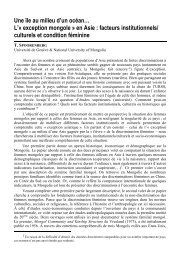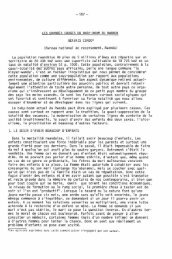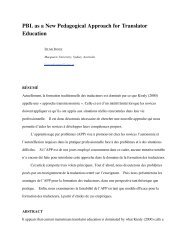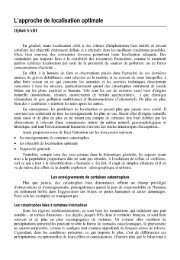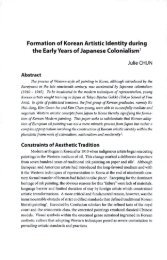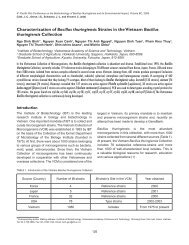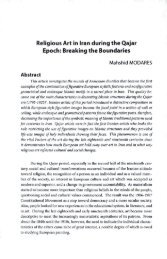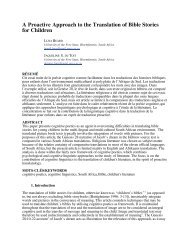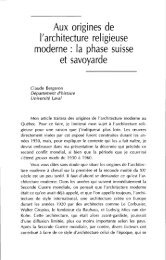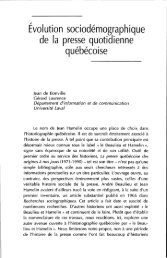Utilization of Bacillus thuringiensis var. israelensis (Bti)-Based ...
Utilization of Bacillus thuringiensis var. israelensis (Bti)-Based ...
Utilization of Bacillus thuringiensis var. israelensis (Bti)-Based ...
You also want an ePaper? Increase the reach of your titles
YUMPU automatically turns print PDFs into web optimized ePapers that Google loves.
compared the susceptibilities <strong>of</strong> Aedes aegypti and<br />
Anopheles albimanus by their feeding rates, found that<br />
the Anopheles larvae ingested ten times less material<br />
than Aedes. This laboratory result may be very important<br />
to explain and interpret the difference in susceptibilities<br />
in the field.<br />
The physiology <strong>of</strong> the Anopheles can also be taken<br />
into consideration when comes the time to explain the<br />
difference in <strong>Bti</strong> efficacy. Figure 3a shows the physiology<br />
<strong>of</strong> Culex and Aedes, where a siphon is present at the<br />
end <strong>of</strong> the body. This siphon allows the larvae to breath<br />
at the water surface. The way the larvae stands in the<br />
water column permits a greater probability to ingest<br />
crystals when the larvae are feeding. Figure 3b, one<br />
can see that Anopheles larvae do not possess a siphon<br />
and must stand parallel to the water surface to breath<br />
and to feed. So, as long as the <strong>Bti</strong> is still in the feeding<br />
zone <strong>of</strong> the larvae (zone smaller than for Culex and<br />
Aedes), crystals are available and a toxic effect can<br />
be observed. However, as soon as the crystals are no<br />
longer in the feeding zone, they can not be captured<br />
and ingested and toxic effects are no longer possible.<br />
Instar susceptibility For most species tested, youngerinstar<br />
larvae are more susceptible than older ones.<br />
Late fourth instars that have ceased feeding or feed little<br />
before pupation are much less susceptible because <strong>of</strong><br />
lack <strong>of</strong> ingestion <strong>of</strong> a lethal dose in a short period <strong>of</strong> time.<br />
Prepupae and pupae are refractory to <strong>Bti</strong> because they do<br />
not feed and do not ingest the toxic particles. Early instars<br />
will definitely be killed by dosages and concentrations that<br />
will induce some mortality in older larvae. In asynchronous<br />
species such as Culex, Anopheles and some Aedes,<br />
all larval instars prevail in the breeding environments.<br />
Administration <strong>of</strong> maximum dosages geared to kill older<br />
larvae will be necessary to control these heterogeneous<br />
larval populations (Mulla, 1990).<br />
Environmental parameters affecting field activity.<br />
Larval density Another important biological factor that<br />
influences larvicidal efficacy <strong>of</strong> <strong>Bti</strong> is the ratio <strong>of</strong> the<br />
quantity <strong>of</strong> toxic particles administered in the water<br />
versus the number (density) <strong>of</strong> larvae (Farghal et al.,<br />
1983 ; Aly et al., 1988 ; Vorgetts et al., 1988 ; Becker<br />
et al., 1992 ; Nayar et al., 1999). In field experiments, a<br />
given dosage <strong>of</strong> <strong>Bti</strong> that will control 95-100% <strong>of</strong> larvae<br />
prevailing at low density will not produce the same<br />
results when larval density is materially increased. In<br />
conditions where high-density populations are met,<br />
90<br />
higher concentrations or dosages will be required to<br />
produce mortalities equal to those that <strong>of</strong> low-density<br />
populations. In general, denser populations <strong>of</strong> larvae<br />
(50-100 larvae per dip) will require 1.5-2 times more<br />
material than the low-density populations (5-20 larvae<br />
per dip) to yield equal mortalities (Mulla et al., 1982).<br />
Suspended organic matter The activity patterns <strong>of</strong><br />
<strong>Bti</strong> can be influenced by environmental factors such<br />
as organic pollution and the presence <strong>of</strong> colloidal<br />
particles, including food particles (Margalit & Bobroglo,<br />
1984 ; Margalit et al., 1985). There seems to be a<br />
direct correlation between the extent and magnitude<br />
<strong>of</strong> organic pollution and the dosage <strong>of</strong> bacterial toxin<br />
required to obtain a given level <strong>of</strong> mortality. Apparently,<br />
in the presence <strong>of</strong> organic and inorganic particles and/or<br />
floating materials, fewer toxin particles are ingested per<br />
unit <strong>of</strong> time than in the absence <strong>of</strong> extraneous materials.<br />
Moreover, the availability <strong>of</strong> crystals is decreased by<br />
their adsorption onto suspended particles followed by<br />
a slow sedimentation. In both cases (high density and<br />
pollution), higher rates <strong>of</strong> application will be necessary<br />
to control mosquito larvae (Mulla, 1990).<br />
Water temperature Water temperature is a very<br />
important factor that needs to be taken into consideration.<br />
Sinègre and Vigo (1980) showed a decreased activity<br />
<strong>of</strong> the endotoxin against Aedes aegypti in the laboratory<br />
at low temperatures (from 17°C to 7°C). Although <strong>Bti</strong><br />
has been found to be active at low temperatures, its<br />
effectiveness may be reduced in cold water due to a<br />
cessation or a low rate <strong>of</strong> feeding <strong>of</strong> some species <strong>of</strong><br />
larvae, larval diapause and a decrease in metabolic<br />
rate (Sinègre & Vigo, 1980). The relationship <strong>of</strong> LC 50<br />
to temperature is affected by the natural temperature<br />
range <strong>of</strong> the insect species, because species living in<br />
cold climates are physiologically adapted to live actively<br />
at lower temperatures than tropical species. Probably<br />
the gut enzymes are geared to have lower temperature<br />
optima. For example, <strong>Bti</strong> is relatively active at 5°C in<br />
snow melt mosquito species.<br />
Other factors commonly encountered in nature, like<br />
slow flowing water (rice fields), intensive vegetative<br />
cover and increased water depth, are also important<br />
considerations that decrease the efficacy <strong>of</strong> <strong>Bti</strong><br />
formulations against mosquitoes (Mulla, 1990) but will<br />
not be discussed here in detail.<br />
As we have seen, many factors can influence the



